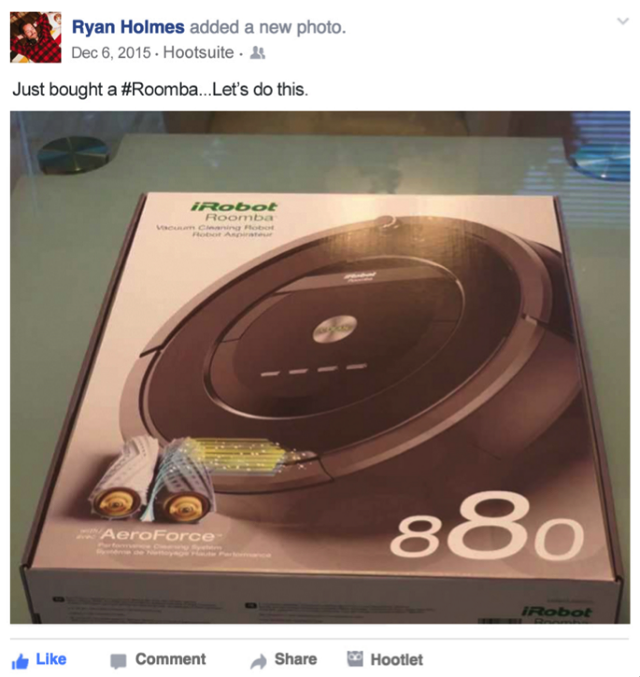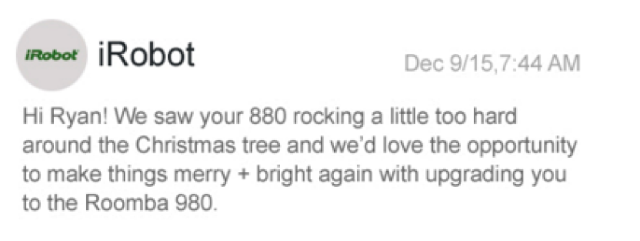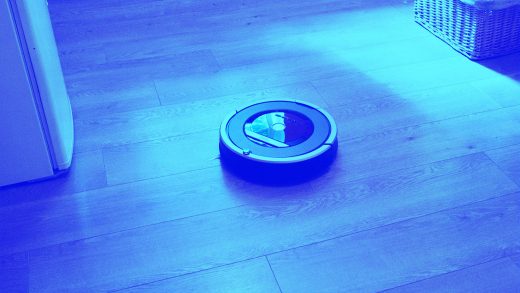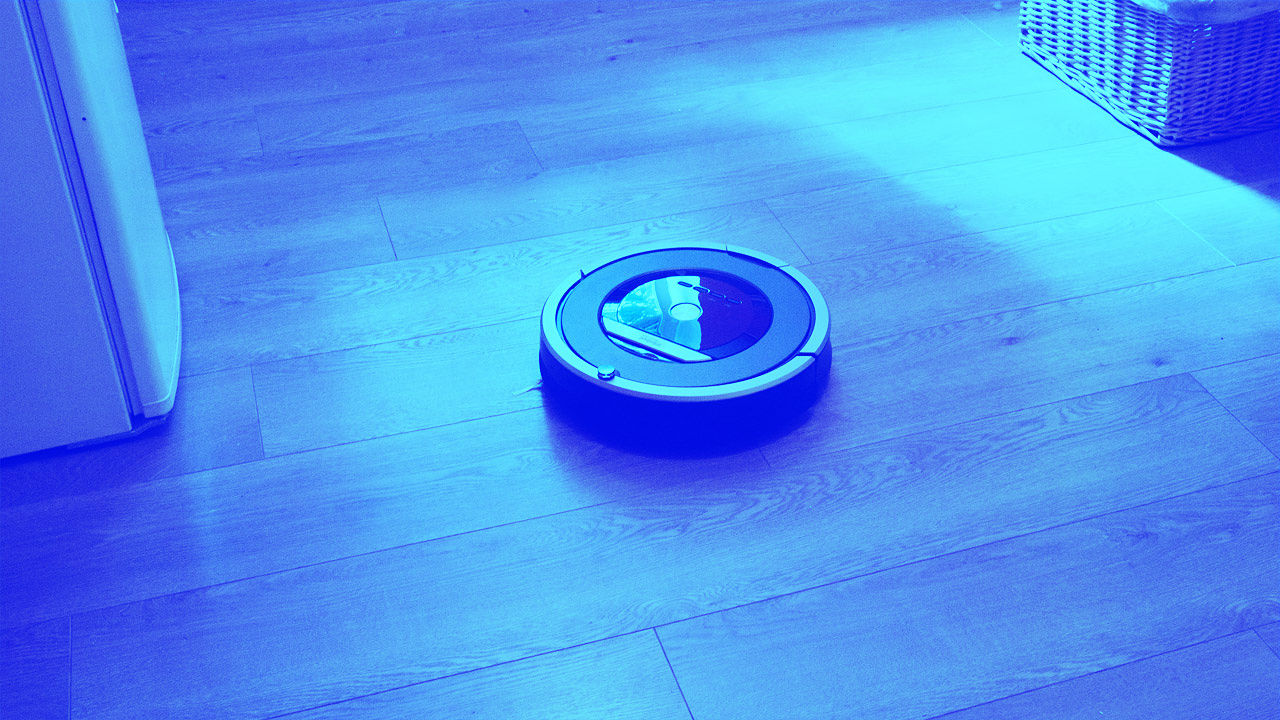How Social Media Is Quietly (Yet Radically) Changing The Way We Buy Stuff
I was a couple years late to the party, but last winter I joined the 9 million-plus people who’ve watched the YouTube classic, “Cat in a Shark Costume Chases a Duck While Riding a Roomba.” The title is pretty much self-explanatory. But after I finished watching (and laughing), what I was really interested in was getting myself a Roomba.
The little robotic vacuum cleaners have been around for more than a decade now, but after some Googling I discovered that recent models have taken things to a whole new level: scheduling, wireless integration, advanced “dirt detection,” etc. I had to have one. What followed was an unintentional crash course in the potential (and pitfalls) of shopping and customer service in the social media era.
Forget What You Know About Customer Experience
It’s no longer news that social media is everywhere. The average user logs in for nearly 1.7 hours every day, or 12 hours a week, according to GlobalWebIndex. By some accounts, millennials watch more YouTube than TV.
But what’s easy to miss—at least from inside big companies—is how fundamentally social media has already changed how we spend not just our time but our money. While we’ve been busy watching cat videos, social platforms have quietly turned nearly every aspect of customer experience on its head.
The way people learn about products, evaluate them, buy them, and interact with companies are being mediated today by social media. Nor are businesses themselves, for the most part, driving this shift; much of the time, they’re catching up to it. It’s one thing to see the stats on this digital transformation (and there are plenty), but it’s another to experience it firsthand when you least expect it—like when you’re shopping for a Roomba.
Now, I’m an early adopter when it comes to technology, and I live and breathe social media at Hootsuite. But for businesses that are just testing the social media waters, my little Roomba saga may shed some light on how Twitter, Facebook, and other networks are quietly and radically reshaping the timeless march long known as the customer journey. To be clear, I’m definitely not a paid Roomba spokesperson, and this shift applies to far more than just robotic vacuums.
Down The Roomba Rabbit Hole
After I had my fill of cats-on-Roombas YouTube videos (turns out this is a whole genre), I got down to the business of picking out my model. Whereas in the distant past this would have involved going down to an electronics store or, in the more recent past, plowing my way through CNET reviews, in this instance I headed over to Twitter and asked my followers if anyone had a Roomba they really loved.
Feedback trickled in. Guided by the wisdom of the crowd (or at least the few friends who replied), I set my sights on the Roomba 880, which was supposedly quieter and more powerful than other models. Interesting side note: While buying the model online, I noticed that the Roomba folks had actually co-opted the whole cat thing in their sales materials—”Just make sure your cat doesn’t hop on board the cleaning extravaganza and turn your Roomba into its personal hoverboard.” In a canny marketing move, what started out as a silly meme on social media found its way into corporate ad copy.
A few days later, my new Roomba arrived—an unboxing that I celebrated, of course, on Facebook. I didn’t really think twice about doing this. You get something new, you post it on Facebook, right?—ideally driving your friends wild with jealousy over your new gadget. (Some YouTube all-stars have taken this to a whole different level, attracting literally millions of views for unboxings of stuff like Disney products.) The flip side, though, is that all this is an especially powerful (not to mention free) form of advertising for the brand in question—not least because the plug is coming from people you know and trust.

Rage And Redemptions On Social Media
Just two days after my triumphant unboxing, however, disaster struck—and my faith in the power of social media was, at least temporarily, tested. While I was at work, my brand new Roomba got a little overzealous around a Christmas tree I’d set up for the holidays. I returned home to find a string of lights gobbled up by the little vacuum, which was stuck at the scene of the crime. Pine needles and smashed ornaments littered the floor. It turned out my $700 Roomba 880 was a total bust. So I did what came naturally. I took to Twitter to vent my frustration.
Businesses have always respected the power of word-of-mouth reviews—especially negative ones. The old adage goes that one happy customer tells three friends, while an unhappy customer tells 10. In the social media era, those numbers need to be raised by an order of magnitude. Worst-case scenario, a creative customer complaint goes viral and reaches millions, generating press coverage and a full-blown PR nightmare. (The classic example: the “United Breaks Guitars” music video, with 15 million views and counting, but there are many, many more.)
What’s clear is that the age of customers trying to navigate automated phone systems, only to be put on hold, is coming to a swift and inglorious end. An estimated 67% of consumers now tap networks like Twitter and Facebook for customer service. And 60% of people who complain on Twitter expect a response within an hour. Many companies, however, are failing to keep up. A recent survey of 500 top retailers shows only 20% of questions sent via Twitter and 54% sent via Facebook get a response—period. And the average response time is more than 27 hours.
But the smart companies are already well ahead of the pack. I had a feeling that by including the #roomba hashtag in my angry Tweet, the customer service team at iRobot (maker of the Roomba) might take notice. And the very next day, they did—and then some.

Because iRobot was active on social media, the company was able to pause my angry rant in its tracks. Their response was fast (relatively speaking), personalized, and done with a dash of humor. More than anything, this little exchange crystallized to me the power and potential of customer service on social platforms. Using simple, cheap tools, iRobot turned what could’ve been a mini PR disaster into an opportunity. (Just how cheap? Some studies show that social media customer service costs around $1 per interaction, versus $6 for phone service.)
And instead of blasting out messages about my awful Roomba experience, I was ready to sing the company’s praises. When a brand new Roomba 980 showed up at my door a few days later, the first thing I did was share a pic with the Twitterverse. I was genuinely appreciative. But, incidentally, this also meant more free advertising for the iRobot team—a likelihood that may well have factored into its decision to send a free vacuum to my doorstep. To give my Tweet some extra juice, I even made sure that my dog Barbie made it into the photo (pets being guaranteed gold on social media).
Now, I realize that my standing as the head of a social media company might have factored in to how iRobot handled my Twitter angst. But that doesn’t disprove the point: The company still had a customer service team in place, not only to actively monitor social media, but who were also trained to respond to customer feedback quickly and meaningfully. Many companies, it’s safe to say, still don’t.
The Mounting Costs Of Playing Catch-Up
What’s the moral of this little social media saga? It’s easy to say that social media is changing how people interact with companies, but it can sometimes be hard to see it up close. The Roomba experience brought that reality home for me, and I don’t think it’s at all unique, even if companies haven’t equally clued in yet. For those that haven’t, the clock is ticking.
Digital natives—people raised on the Internet and social media—already make up 90% of 15–24-year-olds in many developed countries. For companies that want to continue attracting customers, it’s key to fish where the fish are.
Businesses that can sell to customers, address customer service issues, and spread the word-of-mouth gospel on social platforms are tapping into a new and fast-growing audience. Companies that can’t or won’t make the jump stand to see their customer bases erode as business itself becomes ever more social.
In the meantime, I’m pleased to say it’s been four months since my Roomba 980 arrived, and the new model is working like a charm (my Roomba adventures continue here for those interested). Sadly, my dog hasn’t learned to ride it yet (sorry, YouTube), but my floors have never been cleaner.
Fast Company , Read Full Story
(33)














